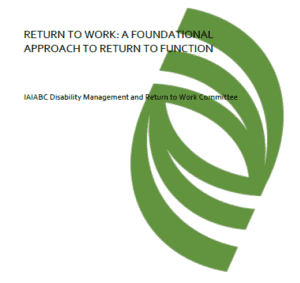
There were many questions from the audience, find response below:
Question: Do we see any plans to try to include the employee’s general practitioner in a case to be a part of the team with a goal of function?
Michael Stack: The recommended best practice in working with medical providers is a working partnership between the employer, employee, and provider.
Vickie Kennedy: This partnership can be supported by the regulator, and facilitated through services offered by the insurer.
Michael Stack: Each party plays an active role in returning an injured employee to work. Depending on state law, this medical provider may or may not be an employee’s general practitioner or a provider of their choice. In addition, this practitioner may or may not have an understanding of occupational medicine, or the employer’s pro-active return to work program, if there is one.
Click Link to Access Free PDF Download
“13 Research Studies to Prove Value of Return-to-Work Program & Gain Stakeholder Buy-In”
Employers are encouraged to gain cooperation from medical providers by developing a good working relationship with a local clinic; invite the provider to your facility, provide job descriptions, and demonstrate commitment to returning employees to work. When an employee is treating with their general practitioner, this physician should absolutely become a part of the team with a goal toward return to function. Employers can help form a relationship with this provider by providing information about your company, transitional duty program, and commitment to employee’s well-being.
Vickie Kennedy: Insurers can assist this effort by helping employers develop return-to-work programs and light-duty jobs before injuries happen, and by offering incentives for bringing a worker back to a job while they heal. These services are particularly critical for smaller employers. They can help workers maintain motivation through relationships with claim managers and by providing vocational support and counseling.
Question: An example: a clinical patient care RN tears a rotator cuff, department accommodates the restrictions during the slow season, shows up late and spends much of the time texting. After surgery the worker is again accommodated with restrictions but shoulder outcome goes downhill resulting in encapsulation and restrictions of no movement away from body and lifting only 5-10 lbs. Then the restrictions went to no use of the arm.
Our hospital had no deskwork outside of her department, you’re not saying that a job should be created to accommodate a worker are you? The department had to fill her position after 6 months as there was not improvement on the horizon.
Michael Stack: The three keys to return to work are Individual, Creative, and Flexible.
First, an employee that is on transitional duty should not be treated any differently than an employee on full duty. What is the consequence of showing up late and texting on full duty? This same consequence should apply on light duty.
Second, while this hospital has a return to work program, it is not effective. Employees should be put in a position that is productive for them and the company. What are this person’s individual talents and skills? What are some productive tasks that can be completed that no one has time for? ASK the employee and supervisors for ideas, there are likely many productive jobs she can do. Without knowing the circumstances of this case, the failure of the first return to work position could have impacted the failure of this employee’s recovery.
Finally, your question regarding creating a new position falls under the ADA laws. For workers’ compensation purposes, light duty should last no more than 90 days and be progressive throughout that time frame. Under the ADA, can she perform full duty with a reasonable accommodation? If the person does reach MMI and still can’t return to full duty, even with a reasonable accommodation, then the employer must consider reassignment to an existing vacant position, as a reasonable accommodation. If there is no work that the person can do, even with a reasonable accommodation, then he/she may be terminated.
Question: It seems that you risk an employee claiming a new exacerbation when they are returned when they would rather not be at work, sad to say, not everyone wants to work.
Michael Stack: The assumption that an injured employee wants to be out of work may or may not be accurate.
Vickie Kennedy: There are several factors that may be at play here: the worker’s fear of re-injury, their relationship with the supervisor and the supervisor’s support for the employer’s return-to-work program are just a couple of examples.
Michael Stack: The best way to ensure compliance with a return to work program is to communicate your policy before an injury occurs, then reinforce the process at the time of injury. Most employees have not had a previous workers’ compensation injury, so they don’t know what to expect. A simple employee brochure outlining your policy, the employers’ role, and the employees’ role is an effective tool.
FREE DOWNLOAD: “13 Research Studies to Prove Value of Return-to-Work Program & Gain Stakeholder Buy-In”
If the employee truly doesn’t want to return to work and has accrued annual or sick leave, then he or she has the right to use it just like other employees. And if the employee is entitled to FMLA leave, then the employer would need to provide the required leave. But if the employee has no leave available, and if everyone agrees that the return-to-work assignment is consistent with the employee’s medical needs, then the employer can require the individual to return. It would be just like requiring someone who hasn’t been injured to come to work, even if he or she would prefer to stay home.*state laws vary, please consult your attorney.
Access IAIABC Whitepaper: Return to Work: A Foundational Approach to Return to Function


Contact: mstack@reduceyourworkerscomp.com.
Workers’ Comp Roundup Blog: https://blog.reduceyourworkerscomp.com/
©2017 Amaxx LLC. All rights reserved under International Copyright Law.
Do not use this information without independent verification. All state laws vary. You should consult with your insurance broker, attorney, or qualified professional.















